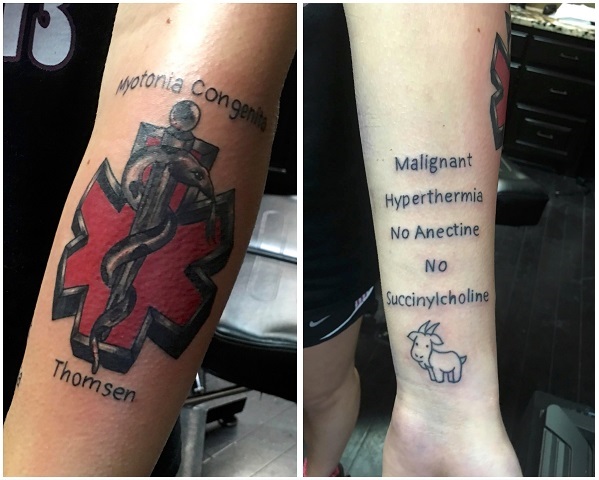NM-344
Medical Alert Tattoos - A Pinch of Style Along with Patient Safety
Bodiford J, Lai E, Nesrsta E, Jain R
McGovern Medical School, UT Health Science Center at Houston, Houston, Texas, USA
Introduction
Medical tattoos have been used since World War II when soldiers would tattoo their blood type on their forearm. We present a patient with Myotonia Congenita (MC) who has an extensive tattoo on both sides of her forearm.
Case
The patient is a 16-year-old who presented for long thoracic nerve decompression. She was diagnosed with myotonia by EMG and genetic testing confirmed Thomsen Disease, a subtype of myotonia. Previously, she presented with history of trouble breathing, prolonged emergence, and severe muscle pain after general anesthesia. After the diagnosis of MC, her mother did further research and correlated post-anesthetic problems with MC and noted an association with Malignant Hyperthermia (MH). The mother wanted an ideal way to alert medical professionals of this risk. The patient had expressed desire for body art and tattoos; they both felt that a medical alert tattoo was the best solution for fulfilling both goals.
Discussion
The use of tattoos as a permanent medical alert can potentially be a life-saving tool. Literature shows several mentions of the value of such tattoos. This patient’s tattoo had a large red “Star of Lifeâ€, a well-known symbol of health care, stating the disease 'Myotonia Congenita' on one side and ‘Malignant Hyperthermia, No Succinylcholine, No Anectine’ on ventral side. The location on the forearm was ideal site for the anesthesiologist since it is a common venipuncture site and would be hard to miss. However, without guidelines, even a large, striking tattoo can be missed in an emergency if the patient's arms are concealed. Having an established tattoo location and symbol to denote a medical alert can prevent tattoos from being overlooked. The literature expresses the need for guidelines for medical personnel and tattoo artists so that medical alert tattoos can share a common symbol and location. Of note, Myotonia Congenita is not associated with Malignant Hyperthermia but because of this tattoo the anesthesiologist in this case was compelled to follow a non-triggering anesthetic. While medical alert tattoos do have great value, one must be cautious to use accurate information in the tattoos.
References:
1. Kluger N, Aldasouqi S.: A new purpose for tattoos: medical alert tattoos. Presse Med 2013.
2. Farbu E, Søfteland E, Bindoff L. Anaesthetic complications associated with myotonia congenita: case study and comparison with other myotonic disorders. Acta Anaesthesiol Scand. May 2003.
3. Parness J, Bandschapp O, Girard T. The myotonias and susceptibility to malignant hyperthermia. Anesth Analg 2009.
4. Haberer J-P, Fabre F, Rose E. Malignant hyperthermia and myotonia congenita (Thomsen’s disease). Anaesthesia. 1989.
5. Hoppe K, Lehmann-Horn F,et,all. In vitro muscle contracture investigations on the malignant hyperthermia like episodes in myotonia congenita. Acta Anaesthesiol Scand. September 2013;57(8): pp. 1017-1023.
Top












